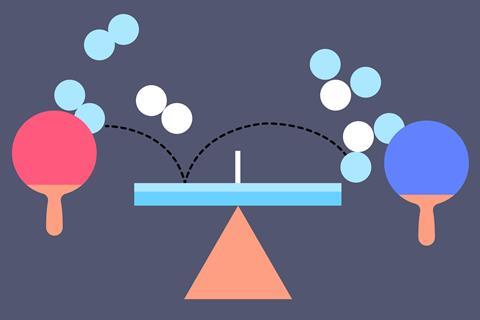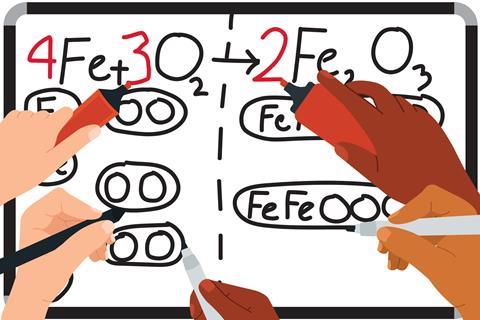Use these tried-and-tested approaches to build student skills and confidence

Balancing equations is a challenging topic to teach. It’s a little bit of applied maths and some foundational concepts about formulas brought together. And it’s crucial for later topics. After the first lesson on this topic with a class, I always feel like I have run a marathon as I whizz around correcting and reassuring.
However, it is also a topic that generates a lot of discussion of different approaches between teachers. Here are five tried-and-tested ways to teach balancing equations.
1. Inspection: the ‘ping-pong’ method
This is the most commonly used classroom method. Students first ‘inspect’ the unbalanced equation, sometimes making a note of the numbers of atoms, and then balance it. The ‘ping-pong’ name comes from the constant reinspection each time a change is made, eyes moving back and forth, and often pen-tapping, from reactants to products. This approach needs a lot of modelling and careful planning of examples. Students need to understand why you’re choosing to add the coefficients, so verbalise your thought process clearly. If you use a visualiser, students can see how to set out the equation.

2. Physical modelling
Using physical manipulatives can help make lessons more engaging and potentially reinforce understanding of ideas about molecular structure and formulas. Molymods are popular, but I am less keen – I don’t like them rolling all over the classroom. Informal models are very engaging; try poker chips, plastic counters or even sweets. The danger with this approach is that the students remember the activity but not the science you were trying to teach them.
3. Mini whiteboards
Many students have a real fear of getting things wrong and this can inhibit their engagement with this topic. I encourage students to use pencil so they can rub things out and to leave plenty of room around the species in an equation, but the best way to get over this fear is mini whiteboards. Students can easily erase errors and you can easily see from a distance what they are doing. Mini whiteboards really help students build confidence. On occasion I have emailed parents of students finding this concept challenging to suggest they buy a mini whiteboard for their child to use at home.

4. Grouping and protecting
One of the most common errors students make is to change the formula of species so the equation is balanced. This can be prevented by protecting the formula during the balancing process. There are several methods for doing this, the most popular expands the formula. For example, MgCl2 becomes MgClCl and the student draws a ring around the species to protect it. To see this method in action, watch @MrTSci409’s video on Twitter.
This method can be seen as foolproof, and when applied correctly it works every time. However, if students forget it and this is the only method they have used, they don’t have anything to fall back on. Typically, applying learned procedures like this may be constraining when the set-up of problems is changed. The details of the method can also add to cognitive load for some students. For these reasons, use this method as a temporary scaffold and remove it as students progress.
5. Reasoning: write to learn
Reasoning approaches can deepen understanding of the underlying concepts in balancing equations. The equation has meaning for the learner and you can then approach more challenging equations using a variety of methods. A write to learn protocol, where students write down their decisions as they balance, can really probe understanding and help teachers to identify where problems are occurring. Additionally, this approach can help to identify where students may be getting the right answer but have incorrect understanding. This can prevent issues later, when equations get more challenging. Don’t use reasoning in isolation. It has many benefits but also takes a lot of time and carries a larger marking burden.
In my classroom I use all these methods at some point in a student’s learning journey with this topic. They make up a kind of toolkit I can draw from when needed.
What are your favourite approaches and activities for this topic? Share them on Twitter with @RSC_EiC














4 readers' comments